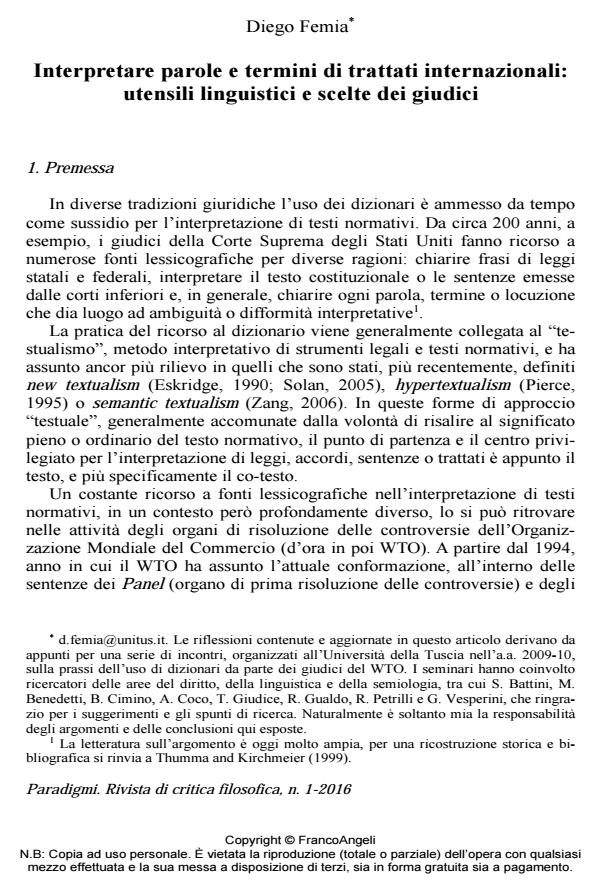Interpretare parole e termini di trattati internazionali: utensili linguistici e scelte dei giudici
Titolo Rivista PARADIGMI
Autori/Curatori Diego Femia
Anno di pubblicazione 2016 Fascicolo 2016/1
Lingua Italiano Numero pagine 15 P. 11-25 Dimensione file 195 KB
DOI 10.3280/PARA2016-001002
Il DOI è il codice a barre della proprietà intellettuale: per saperne di più
clicca qui
Qui sotto puoi vedere in anteprima la prima pagina di questo articolo.
Se questo articolo ti interessa, lo puoi acquistare (e scaricare in formato pdf) seguendo le facili indicazioni per acquistare il download credit. Acquista Download Credits per scaricare questo Articolo in formato PDF

FrancoAngeli è membro della Publishers International Linking Association, Inc (PILA)associazione indipendente e non profit per facilitare (attraverso i servizi tecnologici implementati da CrossRef.org) l’accesso degli studiosi ai contenuti digitali nelle pubblicazioni professionali e scientifiche
In diritto internazionale il tema dell’interpretazione è sempre molto attuale. Questo contributo si propone di descrivere le pratiche interpretative dell’Organiz¬zazione Mondiale del Commercio, con particolare attenzione all’uso da parte dei giudici internazionali di fonti lessicografiche per interpretare parole e termini di trattati multilaterali. Tenendo conto dei diversi livelli di analisi linguistica necessariamente interessati, il contributo presenta una ricognizione storico-statistica del fenomeno e, attraverso la formulazione di una griglia di analisi e la sua applicazione a un primo campione di sentenze, i primi risultati dell’indagine.
Parole chiave:Discorso giuridico, dizionario, interpretazione accordi internazionali, OMC, significato ordinario, vaghezza linguistica.
- Appellate Body Report (1996). United States – Standards for Reformulated and Conventional Gasoline (US – Gasoline). WT/DS2/AB/R.
- Id. (1999). Canada – Measures Affecting the Export of Civilian Aircraft (Canada – Aircraft). WT/DS70/AB/R.
- Id. (1999). India – Quantitative Restrictions on Imports of Agricultural, Textile and Industrial Products (India – Quantitative Restrictions). WT/DS90/AB/R.
- Id. (2000). United States – Tax Treatment for “Foreign Sales Corporations” (US – FSC). WT/DS108/AB/R.
- Id. (2001). European Communities – Measures Affecting Asbestos and Products Containing Asbestos (EC – Asbestos). WT/DS135/AB/R.
- Id. (2004). United States – Final Countervailing Duty Determination with Respect to Certain Softwood Lumber from Canada (US – Softwood Lumber IV). WT/DS257/AB/R.
- Id. (2005). United States – Measures Affecting the Cross-Border Supply of Gambling and Betting Services (US – Gambling). WT/DS285/AB/R.
- Arbitration Report (2002). United States – Tax Treatment for “Foreign Sales Corporations” (US – FSC). WT/DS108/ARB.
- Coco A. e Femia D. (2009). Fonti lessicografiche come mezzi complementari di interpretazione. L’uso del dizionario nella giurisprudenza WTO. Mediazioni, 7: 1-17.
- de Carvalho E.M. (2007). The Decisional Juridical Discourse of the Appellate Body of the WTO: Among Treaties and Dictionaries as Referents. Revue Internationale de Sémiotique Juridique, 20: 327-352, DOI: 10.1007/s11196-007-9049-x
- Id. (2011). Semiotics of International Law: Trade and Translation. Dordrecht: Springer, DOI: 10.1007/978-90-481-9011-9
- De Mauro T. (1999). Introduzione. In: De Mauro T., a cura di. Grande Dizionario Italiano dell’Uso. Torino: Utet: I-XLII.
- Id. (2005). La fabbrica delle parole: il lessico e problemi di lessicologia. Torino: Utet
- Eskridge W.N. Jr. (1990). The New Textualism. Ucla Law Review, 37: 621-91.
- Hobbs P. (2011). Defining the law: (Mis)using the Dictionary to Decide Cases. Discourse Studies, 13(3): 327-347, DOI: 10.1177/1461445611400538
- Kalinowski G. (1974). Sur les langages respectifs du législateur, du juge et de la loi. Archives de Philosophie du Droit, 19: 63-74.
- Mavroidis P. (2006). Looking for Mr and Mrs Right: Ten Years of the Appellate Body at the WTO. In: Sacerdoti G., Yanovich A. and Bohanes J., eds., The WTO at Ten. The Contribution of the Dispute Settlement System. Cambridge: Cambridge University Press: 348-359.
- Panel Report (1996). Japan – Taxes on Alcoholic Beverages (Japan – Alcoholic Beverages II). WT/DS8/R.
- Id. (2011). China – Measures Related to the Exportation of Various Raw Materials (China – Raw Materials). WT/DS394/R.
- Pavot D. (2013). The Use of Dictionary by the WTO Appellate Body: Beyond the Search of Ordinary Meaning. Journal of International Dispute Settlement, 4(1): 29-46, DOI: 10.1093/jnlids/ids009
- Petrilli R. (2013). Semiologia e diritto. In: Gualdo R. e Petrilli R., a cura di. Diritto, linguaggio e letteratura. Perugia: Guerra: 51-70.
- Pierce R.J. Jr. (1995). The Supreme Court’s New Hypertextualism: An Invitation to Cacophony and Incoherence in the Administrative State. Columbia Law Review, 95: 749-95.
- Poggi F. (2007). Contesto e significato letterale. In: Comanducci P. e Guastini R., a cura di. Analisi e diritto 2006. Ricerche di giurisprudenza analitica. Torino: Giappichelli: 169-213.
- Sacco R. (2002). L’interprétation des textes juridiques rédigés dans plus d’une langue. Torino: L’Harmattan Italia.
- Sagri M.T. e Tiscornia D. (2009). Le peculiarità del linguaggio giuridico. Problemi e prospettive nel contesto multilingue europeo. Mediazioni, 7: 1-28.
- Sinclair I.M. (1984). The Vienna Convention on the Law of Treaties. Manchester: University Press.
- Thumma S.A. and Kirchmeier J.L. (1999). The Lexicon Has Become a Fortress: The United States Supreme Court’s Use of Dictionaries. Buffalo Law Review, 47: 227-302.
- Solan L.M. (2003). Finding Ordinary Meaning in the Dictionary. In: Robinson M., ed., Language and the Law: Proceedings of a Conference, Buffalo, NY: William S. Hein & Co.: 255-278.
- Id. (2005). The New Textualists’ New Text. Loyola of Los Angeles Law Review, 38(5): 2027-2062.
- Van Damme I. (2010). Treaty Interpretation by the WTO Appellate Body. The European Journal of International Law, 21, 3: 605-648, DOI: 10.1093/ejil/chq049
- Weiss J.L. (1988). Jurisprudence by Webster’s: The Role of the Dictionary in Legal Thought. Mercer Law Review, 39: 961-76.
- Werbach K. (1994). Looking it Up: The Supreme Court’s Use of Dictionaries in Statutory and Constitutional Interpretation. Harvard Law Review, 107: 1437.
- Zang D. (2006). Textualism in GATT/WTO Jurisprudence: Lessons for the Constitutionalization Debate. Syracuse Journal of International Law and Commerce, 33: 393-444.
- La lingua ordinaria nel diritto: aspetti dell'interdisciplinarità Raffaella Petrilli, in PARADIGMI 1/2016 pp.27
DOI: 10.3280/PARA2016-001003
Diego Femia, Interpretare parole e termini di trattati internazionali: utensili linguistici e scelte dei giudici in "PARADIGMI" 1/2016, pp 11-25, DOI: 10.3280/PARA2016-001002